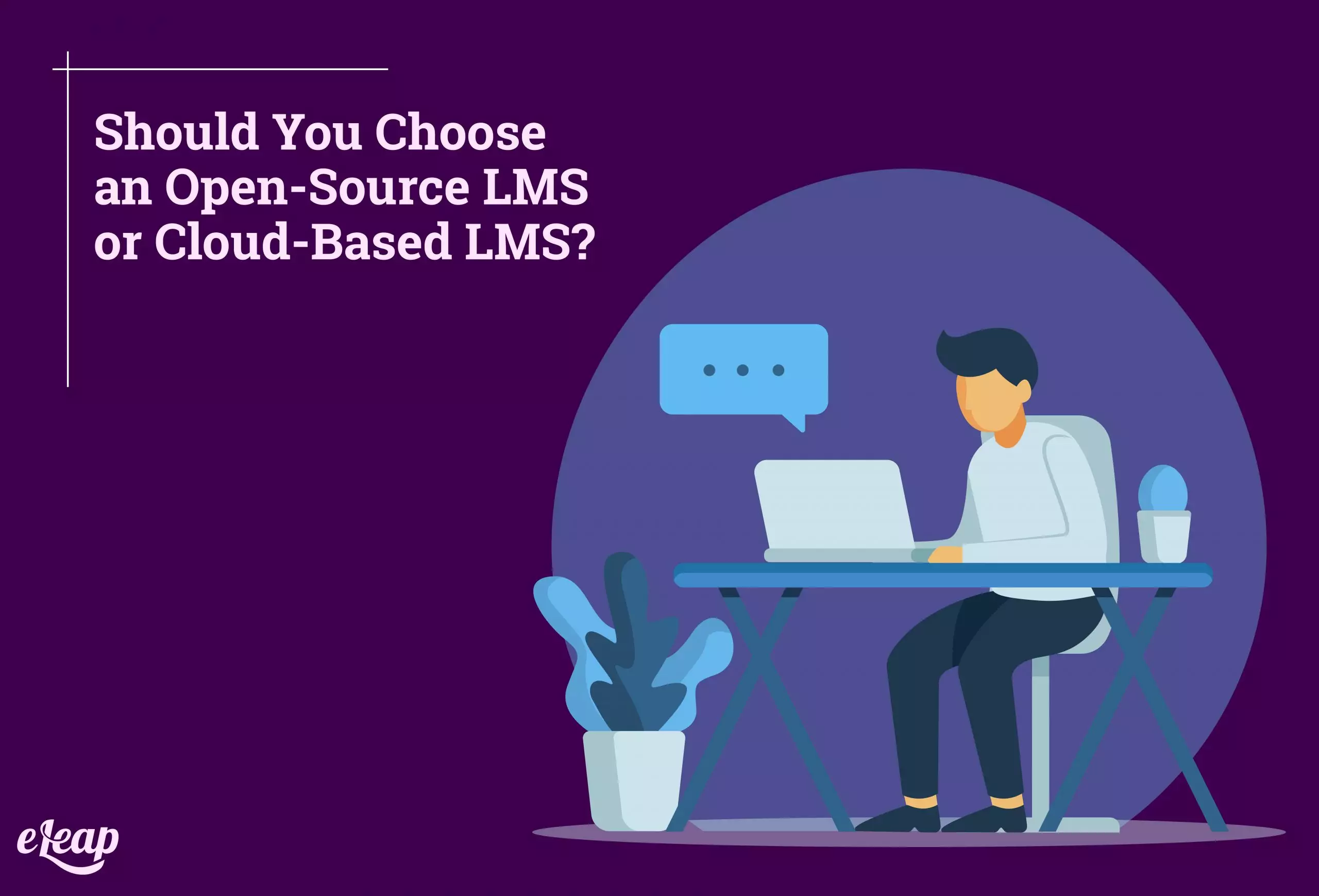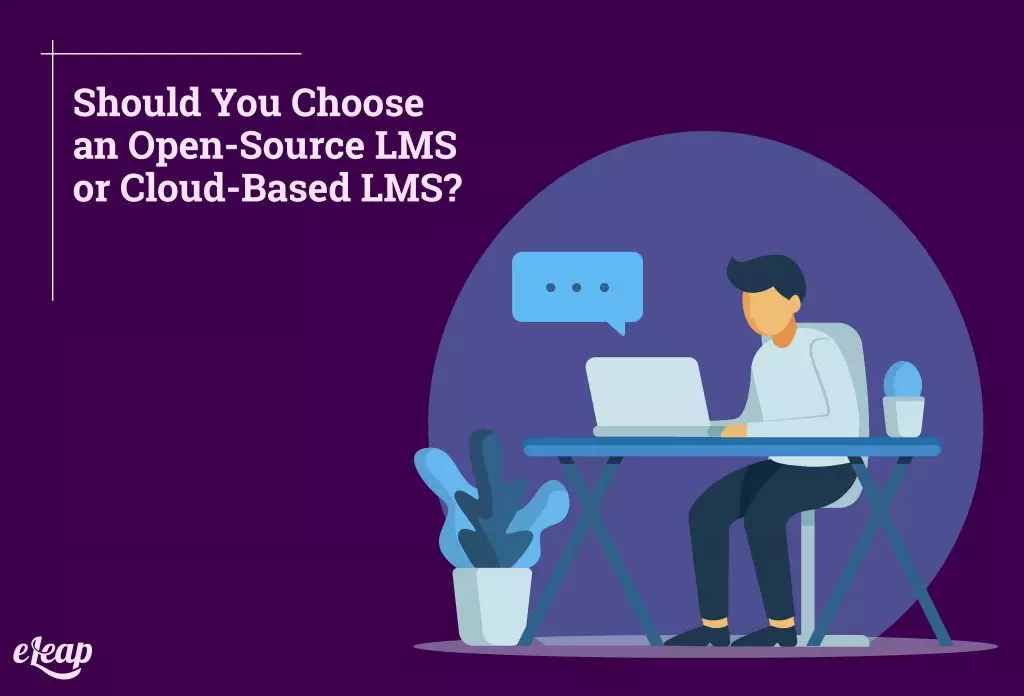Should You Choose an Open-Source LMS or Cloud-Based LMS?

Your learning management system is a vital consideration. It provides you with the means to not just manage learning across the organization, but to track it, to close the skills and knowledge gap, to meet compliance requirements, and so much more. Of course, choosing the right LMS can be pretty challenging, particularly today with the vast evolution that has occurred.

If you’re considering updating your current system or you’re in the market for your first LMS, you’ll need to consider whether you should choose an open-source LMS or go with a cloud-based option. Not sure why one might be better than another? In this post, we’ll explore the differences and help you understand which one might be better suited for your needs, goals, budget, and future requirements.
Open-Source LMS
We’ll begin our discussion with open-source solutions.
What Is an Open-Source LMS?
Open-source simply means that the underlying code of the learning management system is open to all developers. It’s not proprietary. Because the code is freely available, organizations can create their add-ons and other features, rather than having to pay for such additions from the development company.
Key Benefits of an Open-Source LMS
As you might imagine, there are plenty of benefits that you’ll enjoy with an open-source LMS. They’re pretty flexible, for one thing, able to grow with you as your organization evolves. They are also incredibly customizable thanks to the access to the original source code. Finally, these learning management systems are often available free or for a very low cost.
Drawbacks of an Open-Source LMS
While there are plenty of benefits to going with this type of LMS, there are some drawbacks that you need to be aware of. Often, they offset the benefits we just touched on. For instance, while the LMS might be cheap or even free, you’ll need to invest both time and money into developing features and capabilities to suit your organization. That investment will continue over time as your organization evolves, too.
There is also the fact that getting the LMS into position in the first place will require a significant investment of time, money, and resources. You’ll need in-house development talent, or you’ll have to outsource that part and increase your costs. Already, your cost-savings are eroding.
Finally, you need to consider a broad range of other factors that affect the cost, ease of implementation, and your ability to use the system in the first place. These include hosting fees, server-setup, maintenance costs, creating backups, and even providing training for your employees on how to use the LMS.
Cloud-Based LMS
Now we’ll move on to cloud-based learning management systems and how they compare to open-source LMSs.
What Is a Cloud-Based LMS?
A cloud-based learning management system is precisely what it sounds like – a system that is accessible via the Internet. These are generally hosted off-premises, which means you don’t need to tie up your servers or other resources. These are also called “hosted LMSs” for that reason.
Key Benefits of a Cloud-Based LMS
So, what are the benefits offered by this type of LMS? They are pretty significant. One of the most profound is the fact that you can access the system from anywhere, at any time, with any Internet-connected device. That makes it simple for users, developers, managers, and others to access the LMS while they’re traveling, from their homes, and other locations.
Another benefit of a cloud-based LMS is that you’re able to avoid the costs associated with open-source platforms. For instance, there is no setup cost, no costs for development, and no need to pay for a team to manage your LMS. The vendor does all of that. Yes, you’ll pay a fee, usually in the form of a scalable subscription, but that cost is often less than what you would pay with an open-source platform in some cases.
With a cloud-based model, you also gain access to other benefits. For instance, the vendor will usually provide training for your teams or managers. You also get access to support, updates, and even maintenance, all for the same subscription cost.
Speaking of subscriptions – most cloud-based LMS platforms are scalable. They can grow with your business or organization, scaling as necessary to cover your needs and ensuring that you’re never paying for features you don’t need, or need features that you don’t have access to.
Drawbacks of a Cloud-Based LMS
While there are plenty of benefits associated with cloud-based platforms, there are some potential drawbacks that you’ll need to consider. For instance, you give up at least some degree of control over the platform. You may also find that the vendor you choose doesn’t offer all the features or capabilities that you need in the future. Costs can also mount depending on the provider you choose. In addition to your subscription, you may be on the hook for licensing fees. Some companies also charge per user or even per use, so it pays to consider your vendor very closely.
Choosing Your LMS
To make an informed decision here, ensure that you have defined your learning goals and objects. What are the must-have features you need to see in an LMS right now? What about a year from now, or five years from now? Will the LMS be able to support you down the road as well as right this moment? Ultimately, will it support your mission of providing increased training effectiveness and helping your team members achieve success while building a stronger overall organization?
In Conclusion
Both open-source platforms and cloud-based systems have their pros and cons. However, many companies that start with an open-source system ultimately switch to a cloud-based LMS. Monetary savings is one reason, but not the most common. Usually, it’s to gain access to needed features and capabilities. In the end, it doesn’t matter how much money you save on implementation. If the system lacks the features and capabilities that you need, and your organization doesn’t have the development talent to build them in, it’s better to work with a vendor who can support you at each step along the road.